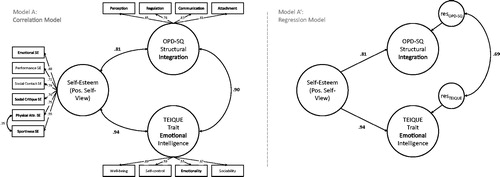Figures & data
Table 1. Models of OPD structural integration and TEIQUE trait emotional intelligence.
Figure 1. Latent variable structural equation models for investigating the relationship between general factors of structural integration and Trait Emotional Intelligence (Study 1) at zero order (model A: correlation model, left) and controlling for self-esteem (model A′: regression model, right). For ease of Interpretation, OPD-SQ scores were reversed so that higher scores indicate higher structural integration. OPD-SQ = Operationalized Psychodynamic Diagnosis – Structure Questionnaire, TEIQUE = Trait Emotional Intelligence Questionnaire, SE = self-esteem. Error terms are not displayed. Loadings of indicator variables are not displayed in model A' as they equal those of model A.

Table 2. Commonality analyses of unique and shared variance of structural integration and trait emotional intelligence on selected clinical personality scales and adaptive/maladaptive psychological functioning (study 1) as well as clinical and nonclinical five-factor model personality dimensions (study 3).
Figure 2. Latent associations of structural integration and personality functioning with Trait Emotional Intelligence and Ability Emotional Intelligence (Study 3). For ease of Interpretation, OPD-SQ and LPFS-SR scores were reversed so that higher scores indicate higher structural Integration / personality functioning. OPD-SQ = Operationalized Psychodynamic Diagnosis – Structure Questionnaire, LPFS-SR = Level of Personality Functioning Scale – Self-Report, TEIQUE = Trait Emotional Intelligence Questionnaire, STEM = Situational Test of Emotion Management. Error terms are not displayed.

